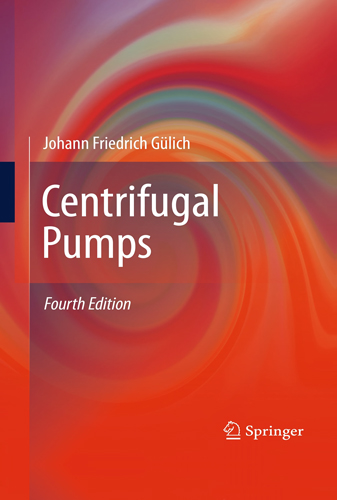Сб с 10 до 16
Centrifugal pumps/Центробежные насосы
Издание на английском языке
Life is linked to liquid transport, and so are vital segments of economy. Pumping devices - be it the human heart, a boiler feeder or the cooling water pump of a motorcar - are always part of a more or less complex system where pump failure can lead to severe consequences. To select, operate or design a pump, some understanding of the system is helpful, if not essential. Depending on the application, a centrifugal pump can be a simple device which could be built in a garage with a minimum of know-how - or a high-tech machine requiring advanced skills, sophisticated engineering and extensive testing. When attempting to describe the state of the art in hydraulic engineering of centrifugal pumps, the focus is necessarily on the high-tech side rather than on less-demanding services even though these make up the majority of pump applications.
Centrifugal pump technology involves a broad spectrum of flow phenomena which have a profound impact on design and operation through the achieved efficiency, the stability of the head-capacity characteristic, vibration, noise, componentи failure due to fatigue, as well as material damage caused by cavitation, hydro-abrasive wear or erosion corrosion. Operation and life cycle costs of pumping equipment depend to a large extent on how well these phenomena and the interaction of the pump with the system are understood.
Contents
1 Fluid Dynamic Principles
1.1 Flow in the Absolute and Relative Reference Frame
1.2 Conservation Equations
1.3 Boundary Layers, Boundary Layer Control
1.4 Flow on Curved Streamlines
1.5 Pressure Losses
1.6 Diffusers
1.7 Submerged Jets
1.8 Equalization of Non-uniform Velocity Profiles
1.9 Flow Distribution in Parallel Channels, Piping Networks
References
2 Pump Types and Performance Data
2.1 Basic Principles and Components
2.2 Performance Data
2.3 Pump Types and Their Applications
References
3 Pump Hydraulics and Physical Concepts
3.1 One-Dimensional Calculation with Velocity Triangles
3.2 Energy Transfer in the Impeller, Specific Work and Head
3.3 Flow Deflection Caused by the Blades. Slip Factor
3.4 Dimensionless Coefficients, Similarity Laws and Specific Speed
3.5 Power Balance and Efficiencies
3.6 Calculation of Secondary Losses
3.7 Basic Hydraulic Calculations of Collectors
3.8 Hydraulic Losses
3.9 Statistical Data of Pressure Coefficients, Efficiencies and Losses
3.10 Influence of Roughness and Reynolds Number
3.11 Minimization of Losses
3.12 Compendium of Equations for Hydraulic Calculations
References
4 Performance Characteristics
4.1 Head-Capacity Characteristic and Power Consumption
4.2 Best Efficiency Point
4.3 Prediction of Pump Characteristics
4.4 Range Charts
4.5 Modification of the Pump Characteristics
4.6 Analysis of Performance Deviations
4.7 Calculation of Modifications of the Pump Characteristics
References
5 Partload Operation, Impact of 3-D Flow Phenomena Performance
5.1 Basic Considerations
5.2 The Flow Through the Impeller
5.3 The Flow in the Collector
5.4 The Effects of Flow Recirculation
5.5 Influence of Flow Separation and Recirculation on the Q-H-Curve
5.6 Means to Influence the Shape of the Q-H-Curve
5.7 Flow Phenomena in Open Axial Impellers
5.8 Flow Instabilities in Double-Entry Impellers and Double Volutes
5.9 Concluding Remarks
References
6 Suction Capability and Cavitation
6.1 Cavitation Physics
6.2 Cavitation in Impeller or Diffuser
6.3 Determination of the Required NPSH
6.4 Influence of the Fluid Properties
6.5 Cavitation-Induced Noise and Vibrations
6.6 Cavitation Erosion
6.7 Selection of the Inlet Pressure in a Plant
6.8 Cavitation Damage: Analysis and Remedies
6.9 Insufficient Suction Capacity: Analysis and Remedies
References
7 Design of the Hydraulic Components
7.1 Methods and Boundary Conditions
7.2 Radial Impellers
7.3 Radial Impellers for Small Specific Speeds
7.4 Radial Impellers for Non-clogging Pumps
7.5 Semi-axial Impellers
7.6 Axial Impellers and Diffusers
7.7 Inducers
7.8 Volute Casings
7.9 Radial Diffusers with or Without Return Channels
7.10 Semi-axial Diffusers
7.11 Volutes Combined with a Diffuser or Stay Vanes
7.12 Annular Casings and Vaneless Diffusers
7.13 Inlet Casings for Between-Bearing Pumps
7.14 Analytical Method for Impeller Design
References
8 Numerical Flow Calculations
8.1 Overview
8.2 Quasi-3D-Procedures and 3D-Euler-Calculations
8.3 Basics of Navier-Stokes Calculations
8.4 Averaging and Post-processing
8.5 Impeller Calculations
8.6 Calculation of Collectors and Stages
8.7 Two-Phase and Cavitating Flows
8.8 Calculation Strategies, Uncertainties, Quality Issues
8.9 Criteria for Assessment of Numerical Calculations
8.10 Fundamental Considerations on CFD-Calculations
References
9 Hydraulic Forces
9.1 Flow Phenomena in the Impeller Sidewall Gaps
9.2 Axial Forces
9.3 Radial Forces
References
10 Noise and Vibrations
10.1 Unsteady Flow at the Impeller Outlet
10.2 Pressure Pulsations
10.3 Component Loading by Transient Flow Conditions
10.4 Radiation of Noise
10.5 Overview of Mechanical Vibrations of Centrifugal Pumps
10.6 Rotor Dynamics
10.7 Hydraulic Excitation of Vibrations
10.8 Guidelines for the Design of Pumps with Low Sensitivity to Vibrations
10.9 Allowable Vibrations
10.10 General Vibration Diagnostics
10.11 Bearing Housing Vibrations: Mechanism, Diagnostics, Remedies
10.12 Hydraulic and Acoustic Excitation of Pipe Vibrations
10.13 Torsional Vibrations
10.14 Vertical-Pump Vibrations
References
11 Operation of Centrifugal Pumps
11.1 System Characteristics, Operation in Parallel or in Series
11.2 Pump Control
11.3 Static and Dynamic Stability
11.4 Start-Up and Shut-Down
11.5 Power Failure, Water Hammer
11.6 Allowable Operation Range
11.7 The Approach Flow to the Pump
11.8 Discharge Piping
References
12 Turbine Operation, General Characteristics
12.1 Reverse Running Centrifugal Pumps Used as Turbines
12.2 General Characteristics
References
13 Influence of the Medium on Performance
13.1 Pumping Highly Viscous Fluids
13.2 Pumping of Gas-Liquid Mixtures
13.3 Expansion of Two-Phase Mixtures in Turbines
13.4 Hydraulic Transport of Solids
13.5 Non-Newtonian Liquids
References
14 Selection of Materials Exposed to High Flow Velocities
14.1 Impeller or Diffuser Fatigue Fractures
14.2 Corrosion
14.3 Erosion Corrosion in Demineralized Water
14.4 Material Selection and Allowable Flow Velocities
14.5 Hydro-abrasive Wear
References
15 Pump Selection and Quality Considerations
15.1 The Pump Specification
15.2 Determination of Pump Type and Size
15.3 Technical Quality Criteria
15.4 High-Energy Pumps
References
16 Pump Testing
16.1 Types of Tests and Measurements to Be Taken
16.2 Test Loop Configurations
16.3 Instrumentation
16.4 Test Preparation and Test Procedures
16.5 Test Evaluation and Accuracy
16.6 Potential Testing Problems and Remedies
References
17 Appendices
17.1 Units and Unit Conversion
17.2 Properties of Saturated Water
17.3 Solution of Gases in Water
17.4 Physical Constants
17.5 Sound Velocity in Liquids
17.6 Mechanical Vibrations-Basic Notions
17.7 Hydraulic Specification
References
Bibliography
Index




